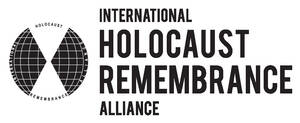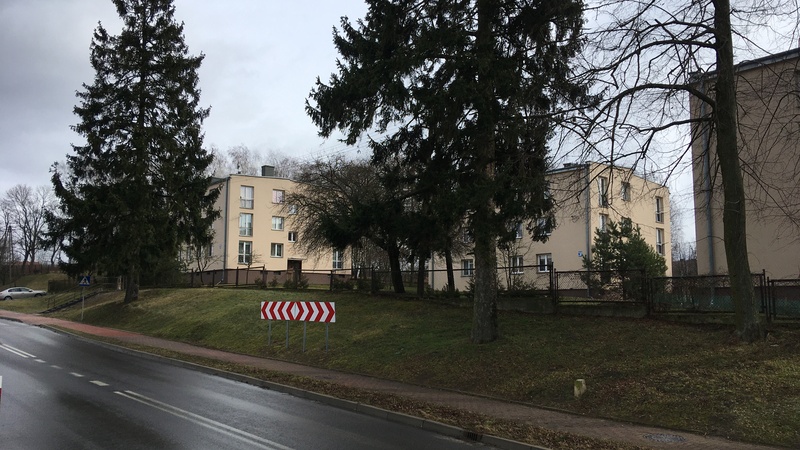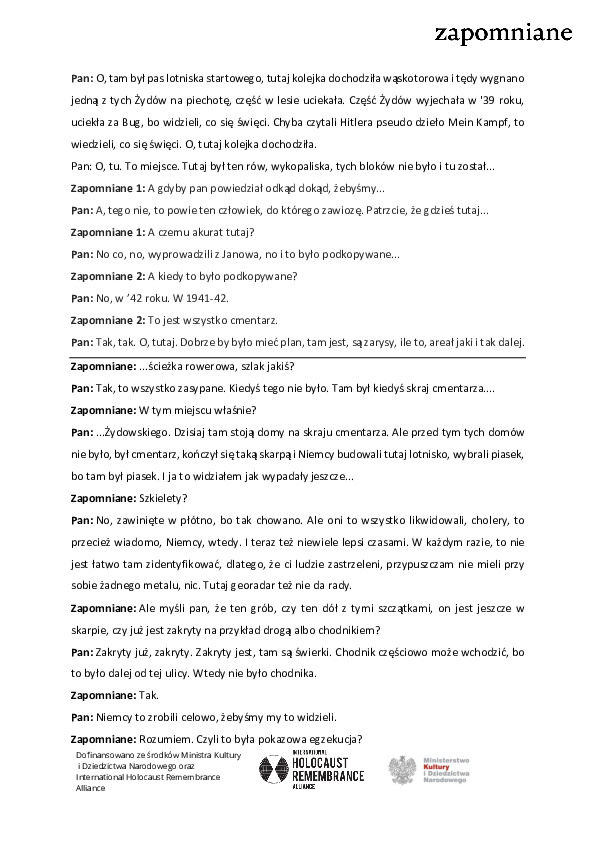Janów Podlaski
Borough of Janów Podlaski , Janowski District, Lubelskie VoivodshipType of place
Traffic laneInformation about the crime
In the winter and early spring of 2022, we carried out a site inspection of an unmarked Jewish grave in Janów Podlaski. We met two local residents at the site. They shared their knowledge of the massacre that took place in Janów probably in the spring of 1941.
One of them was Krzysztof Wawrzyniak a.k.a. Norblin:
“And how do I know all this? Because my father at the time was the fire chief. The fire department then was under the command of the German military police. The firefighters were ordered to bury the execution victims. I was there with my father and many other firefighters. About nine people were killed, including one woman.
– How were the victims selected for execution?
– I do not know exactly how Germans made their decision. The victims were successful traders who had some resources.
– Did they try to solicit a bribe from them?
– No. It was terror only. They simply wanted to kill 10 people to show others: Be careful, because it can happen to you too.
– Did you see the execution itself?
– No. I don’t think anyone in Janów saw that.
– So the Poles only saw the bodies afterwards?
– The bodies were already lying on the ground. With the help of a German machine that was used to work at the airport, they dug a trench about six meters long, about the size of a man.
– So the ditch was specially dug for this?
– Yes, everything was prepared”. (Janów Podlaski, February 21, 2022)
Norblin also included information about this execution in his book Z wiatrem i pod wiatr: “When I was young, together with my father I was present at many actions. We were everywhere. Sometimes we went with firefighters to exercises held at the marketplace. We also witnessed very unpleasant incidents in which the Germans involved the fire department. One of these events was the burial of murdered Jewish merchants. The crime was committed by Gestapo officers in late April and early May 1941. The victims were: Boruch Epelman, Rozla Czern, Rywka Kaufman, Aaron Szerman, Peres Rydlewicz, Hersz Kaufman, Icek Szyja, Mejer Edelkopf and Icek Rubinsztajn. They were all buried in a roadside ditch next to the road leading to Biała Podlaska”. (Norblin, 2020)
The following names appear in the list of the victims from the Biała Podlaska district:
Icko Rubinsztejn, age 24, last place of residence: Janów Podlaski,
Mejer Edelkopf, age 26, butcher. last place of residence: Janów Podlaski, Siedlecka street,
Icko Szyja, age 26, miller, last place of residence: Janów Podlaski,
Peretz Rydlewicz, age 25, painter, last place of residence: Janów Podlaski, Siedlecka street,
Herszko Kaufman, age 53, butcher, last place of residence: Janów Podlaski, 1 Maja street.
Aron Szerman, age 28, hairdresser, last place of residence: Janów Podlaski, Brzeska street,
Boruch Epelbaum, age 58, last place of residence: Janów Podlaski, Rynek street.
According to the list, they all died in 1942, so a year later than Krzysztof Wawrzyniak remembered. The list also does not mention the two women who, according to Wawrzyniak, were also murdered at the time. (IPN Lu 504/2)
Marian Cypel also recalls the murder of 10 Jews from Janów in the spring of 1941 or 1942: “In April or May, at night, the Gestapo officers 10 Jews from Janów. Most of them were local merchants who were led near the local Jewish cemetery and shot there. Here are their names: Boruch Epelbaum, Rozal Czerny, Rywka Kaufman, Aaron Szerman, Hersz Kaufman, Peres Rydlewicz, Icek Szyja, Mejer Edelkopf and Icek Rubinsztajn. After the murder, they were all buried in a roadside ditch near the road leading to Biała Podlaska. More or less at the place where Kazimierza Jagiellończyka Street is now located. Perhaps they still lie there to this day”. (Cypel, 1993)
The presence of the name Peretz Rydlewicz mentioned in all the above sources is questionable. According to Andrzej Tłomacki, Rydlewicz was killed in 1946 along with four other residents of a house at 2 Siedlecka Street in Janów Podlaski. “In a report dated March 22, 1946, the head of the Provincial Office of Public Security in Lublin, Franciszek Marszałek informed his superiors that five Jews had been murdered at 11 pm on March 9. (…) According to people who wished to remain anonymous, Herszko Goldberg, a local butcher, was murdered along with Rydlewicz. The remaining witnesses to the incident, i.e. an unknown Jew Jutka, who came to Poland from Russia in 1945, and a Polish woman bearing the maiden name Brzeska, along with her child, were taken to the forest and shot there”. (Tłomacki, 2006)
Krzysztof Wawrzyniak still remembers his Jewish colleagues:
„Brzeska Street was the Jewish street and part of the so-called Terespol Road. And we all had fun on that road. Abram, Gitla, Gołda, Szlom. They were my friends. In the beginning we still went to school. Even Abram, he lived here. Over there, where those tall trees grow. His father was a furrier. He was a great singer. I got a double harmonica from my grandfather. I didn’t know how to play, but I went out on the road and started blowing. Abram heard it and said: “let me play”. I said: “there you go”. As he started to play… As he started to play, I said: “come play for my grandfather”. Grandfather said to me: “You can’t play. Give him the harmonica”. So I gave it to him. They were all murdered, deported from the ghetto, first to Biała Podlaska. Then some of them were transported to Międzyrzec”. (Janów Podlaski, February 21, 2022)
In addition, the following murders of Jews took place in Janow Podlaski:
In October 1942, at 10 o’clock in the morning, two Jewish women were shot. “Gestapo officers going in the direction of Hołodnica-Rokitno saw two Jewish women, Ruzal Czerny and Rywka Kaufman (…) on the road. They were returning from Werchliś. They were stopped near the parish cemetery and were shot there by three Gestapo men”. (IPN Lu 501/4)
In December 1942, in a forest district called “Udokowiec”, on Czeslaw Kalenda’s plot, Schutzpolizei officers murdered three Jews: Szaja Ruzal (36 years old), Szloma Ruzal (32 years old) and Aron Ruzal (28 years old). All three men were butchers from Janow Podlaski. “Their shelter in the field was pelted with grenades, then doused with gasoline and burned”. (IPN Lu 501/4)
Sources
Transkrypcje
Contact and cooperation
We are still looking for information on the identity of the victims and the location of Jewish graves in Janów Podlaski. If you know something more, write to us at the following address: fundacjazapomniane@gmail.com.
Bibliography
Recordings of the Zapomniane Foundation (audio file), name: Krzysztof Wawrzyniak Norblin, topic and keywords: Janów Podlaski, Jews, interviewed by Agnieszka Nieradko and Andrzej Jankowski, February 21 and March 31, 2022.
Krzysztof Wawrzyniak Norblin, Z wiatrem i pod wiatr, Janów Podlaski, 2020.
Andrzej Tłomacki, Stosunki polsko-żydowskie na terenie południowo-wschodniego Podlasia w latach 1944-1947 na przykładzie gminy Janów Podlaski, Radzyński Rocznik Humanistyczny 4, 187-200, 2006
Marian Cypel Gawęda o Janowie Podlaskim, Warsaw 1993
IPN Lu 504/2 List of people murdered during the German occupation in Biała Podlaska district drawn up by the Presidia of the National Councils, 1968-1971
IPN Lu 501/4 Surveys of The Regional Commission for the Examination of German Crimes in Lublin collected in 1968-1969, concerning the places and facts of German crimes in Biała Podlaska district.
We have collected the materials about this village thanks to the funding provided by the International Holocaust Remembrance Alliance as part of the project “The rural Holocaust. Collecting and safeguarding the never recorded testimonies 100 forgotten Jewish graves 2021-2022”. The materials for this website were developed, digitized and made available as part of the project “Development of a digital archive of Jewish war graves outside the extermination camps and educational use of archive resources” thanks to funding from the Minister of Culture and National Heritage from the Cultural Promotion Fund.

 Janów Podlaski zdjęcie lokalizacji
Janów Podlaski zdjęcie lokalizacji IPN Lu 501-4 Ankiety Okręgowej Komisji Badania Zbrodni Hitlerowskich - Janów Podlaski
IPN Lu 501-4 Ankiety Okręgowej Komisji Badania Zbrodni Hitlerowskich - Janów Podlaski Janów Podlaski - transkrypcja
Janów Podlaski - transkrypcja